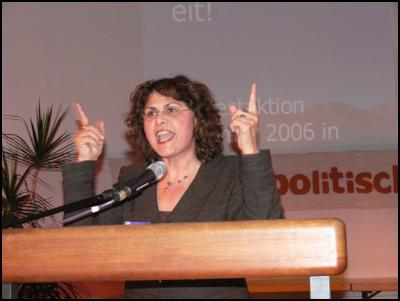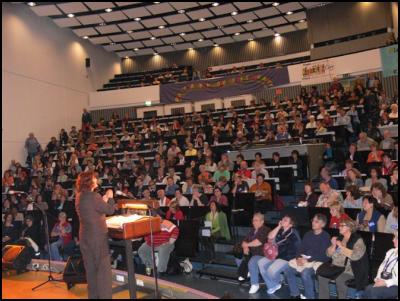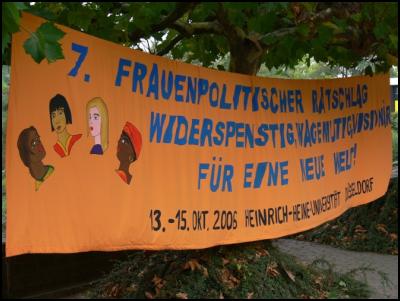The Reality of Iran's Women’s Liberation Movement
Mass Resistance is the Other Side of Large Scale
Oppression:
The Reality of the Women’s Liberation
Movement in Iran
A speech by Azar Majedi, given at the International women’s right conference in Dusseldurf, Germany 12-14 October, 2006

In describing women’s conditions in a particular country, one either refers to laws governing that country or statistics which measure women’s status. In this manner, one either exposes the extent of the oppression women suffer or admires their achievements. In regards to women living under the rule of Islam, the situation is pure discrimination and oppression, subjugation and state violence. If women are considered second class citizens in many countries, in countries stricken by political Islam, they are not even considered as citizens. They are only extensions of men. In fact, according to Islam, the concept of citizenry is non-existent. There is a relationship between God and the religious hierarchy and a collective of right-less, conscious-less men, with women as their slaves. As a matter of fact, this is true of any other religion. However, this is beside the point of today’s discussion.
You have heard a great deal about women under Islam, Islam a la Taliban, in Pakistan, in Bangladesh, Somalia, Sudan, and in Iran under the Islamic Republic. The downtrodden situation of women, the sheer discrimination, gender apartheid, Islamic veil, forced marriages, officially recognized pedophilia, (setting the legal age of marriage at 9 for girls), honour killing, polygamy, stoning women to death for engaging in sex outside marriage, encouraging men to hit their wives for punishment. The list is long.
If once the issue of Islam and women was an unknown topic, nowadays, thanks to the rise of political Islam, Islamic states in Iran, Afghanistan, and now in Iraq, it has become a well-known topic. I am sure that you all have heard about the non-existence of women’s rights in Islam. However, some think it is not Islam’s fault, they blame the patriarchy. They maintain that it is not Islam, but patriarchal interpretations of Islam that is responsible for the conditions of women in countries under the rule of Islam. In other words, it is the ruling men’s fault not the ruling Islam. We will not get into the debate that Islam, as with all other religions, is the direct product of a patriarchal era. It could not have escaped being permeated by patriarchic values and outlooks. However, we must state one undeniable fact: which is that millions of women are violated daily by Islamic laws, customs, values and states. We must deal in an effective manner with this violation.
I am here on behalf of the Organization for Women’s Liberation. I am here to familiarize you with realities of Iranian society. You have heard about Iran. I do not mean the oil, or the nuclear project. I do not mean the mullahs or the fatwa against Salman Rushdie. I mean about the situation of women. Today, I want to talk to you about women’s resistance, rather than women’s oppression. You have heard long tales about women’s oppression. I would like to tell you that there is a mass resistance movement against this systematic oppression, this official misogynistic ideology. I would like to share the encouraging news with you that Iran is the birthplace of a very important historic moment in international women’s liberation, a movement more significant than the Suffrage movements, or as vast as the women’s liberation movement in the Soviet Union from 1917 to 1930, or in the West during the 1960s and 1970s. This movement has great potential. If it materializes, it is capable of not only liberating women in Iran, but also opening up the door to freedom to all women of the Middle East. We must recognise this fact. I am here to ask for your solidarity and support.

The situation in Iran is different from that of Afghanistan, Iraq or the Sudan. There is mass discontent in these countries; there is resistance, but there is a lack of a mass movement in defense of women’s rights. Such a movement exists in Iran.
In Iran there has never existed a secular state or the separation of religion from the state and education. The laws have always been religious laws. There has always been a dictatorship. The efforts to reform the family law in favour of women during the 1960s were very meager and not very effective. During the 1979 revolution, a women’s right movement was born. This was not a mass movement, but rather was formed by left and intellectual women. I am from that generation. My struggle for women’s rights and for freedom and equality predates that period.
After the Islamic Republic came to power, they attacked women full-force. In 1979, we organised several March 8 celebrations in Tehran. The society was free from monarchist dictatorship, and we, the women’s rights activists, were celebrating March 8 for the first time. On the same day, Khomeini ordered women to wear the veil. A large demonstration took to the streets in protest to this reactionary order and demanded women’s equality. The protest continued for almost a week, meetings, and a sit-in were organize. Finally the government gave in to women’s demands. A year later women employees were ordered to observe the veil at work, some women protested, hundreds lost their jobs. The first phase of the women’s movement was short-lived. It put up a brave resistance, but it was silenced after two years.
Women’s resistance continued in individualistic fashion, against the veil, gender apartheid and obligatory dress code. Many women have been imprisoned, tortured, flogged, or stoned to death. This brutal oppression was not able to obliterate the spirit of resistance. The new generation reignited this movement on a mass scale and has pushed it forward. Fighting against the Islamic veil and apartheid is one of the main battlegrounds.
When I hear the apologists of the Islamic movement or the defenders of cultural relativism (which, thanks to our relentless struggle has become a marginal tendency) say: “the Islamic veil and apartheid is their culture,” I get furious and want to laugh at the same time. If this is “their culture” then it is supposed that they practice it voluntarily. Why then has this massive means of oppression become necessary? Why are all these special forces formed to deal with cultural disobedience, non-observance of the veil and gender apartheid? I would like to ask-- are these people a bunch of masochists-- who like to practice their culture by being tortured, imprisoned and stoned? What rubbish! The thousands of women who have been tortured, stoned and executed, are the symbol of a vast movement against the Islamic laws, gender apartheid and veil.

I believe there is a straightforward equation: a complex and sophisticated oppressive system only demonstrates that there is a vast and complex resistance to be suppressed. When there are more than one hundred thousand political executions, this bitter and tragic fact reveals that the society does not accept the existing order and wants change.
In Iran, there is a special police force to deal with women, those who protest, those who do not observe the veil and those who challenge the dress code with fashion innovation. This special force was used to crush a demonstration to protest against women’s condition that took place in Tehran in July. Despite all the laws governing dress code and observing the veil, despite prison sentences, fines and flogging, women in Iran ridicule the veil and in their demonstrations have also burned it. The new generation cannot be silenced, cannot be forced back home. This is the resistance I am talking about.
In Iran, there is a vast secular movement for a free and egalitarian society. The women’s liberation movement is one of the main components of this general movement. The de facto status of women is much higher than their official and legal status. In the eyes of the dominant ideology and legislation, women’s status is half of that of men. A woman is the man’s slave. She cannot travel or work without her “master’s” permission, does not have divorce or child custody rights, cannot become a judge or a president. But women in Iran could not be subdued or made to accept this status and image. They want to be whole persons, independent and equal.
I would like to mention a statistical figure: around 66% of entering university students are female. This is in a country where you need to pass difficult entry exams. The competition to get into college is very high. You also have to take into consideration the state’s efforts to push women into the home. Is this statistic accidental? No. This is a trend. Every year this figure has risen, from 30% to 66%. The parliament tried to pass laws to reverse this trend, to prevent women from getting into the university in these high numbers. The representatives of the Islamic parliament argued that this is very detrimental to Islam and the institution of the family. They were alarmed by these statistics. I become overjoyed. This shows a resilient determination on the part of the new generation of women in Iran. This brings hope and shows that women’s liberation in Iran is alive and kicking.
March 8th, International Women’s Day, has become an established tradition in Iran. In the past few years, March 8th has been celebrated in different cities and in different ways throughout Iran. The first time was in 1979 after the collapse of the monarchist regime. This was the birth of a women’s right movement which was silenced after 2 years There was an interruption for several years. In year 2000 a large and open meeting is organized in University of Sharif in Tehran in commemoration of 8 March. The news about small gatherings in different cities have also been spread..
The Islamic Republic tried a propaganda tactic-- it named the birthday of Mohammad’s daughter as the national women’s day. The specialty of this regime has been to suppress movements not only by brutal force, but by means of demagogic propaganda. It crushed the 1979 revolution by calling its state a revolutionary state, its brutal forces the revolutionary guards, and the revolution itself, an Islamic revolution. It disarmed the left by taking over the so-called anti-imperialist movement, by manipulating the anti-American sentiment and taking Americans hostage at the American Embassy. Attempting to substitute the Prophet’s daughter’s birthday for international women’s day was a similar tactic. However, this tactic only worked for a few years. Then it was forced to assign a women’s week. This did not work either. Last year, it was forced to admit defeat and a faction of the regime recognized March 8 as women’s day. March 8th now is an established tradition in Iran. Last year there were many different rallies and meetings organised to commemorate March 8. Some of them, including the one in Tehran, were suppressed. Three months later there was a large protest organised in Tehran to demand reforms in favour of women, several thousand took part. This was also crushed by the wecurity forces and the new special women’s force. Many were arrested and beaten up. A couple of months later a movement was initiated to collect 1 million signatures for changing the laws in women’s favour. The women’s liberation movement is not going to give up or be silenced. The Islamists try to crush it and it rises again even stronger. It seems that all efforts to suppress it, only make it stronger and more resilient.
These are the positive aspects of women’s resistance. Unfortunately, there is a dark and sad dimension to it as well. The number of suicides and setting fire to oneself has increased considerably among women, especially among young women. Women in Iran have always lived under discrimination. Forced marriages, extensive restrictions on their lives, being placed in servitude status vis a vis the men has always been the fact of life for the majority of women in Iran. It seems that at one time they accepted this as a divine and natural law, and resigned themselves to it. However, in the past decade, we are witnessing a significant rise in women’s suicide. This is a protest. The new generation has different expectations and aspirations. Women are not resigned to their “fate.” They want to take their fate into their own hands. When a woman cannot protest collectively, when she cannot direct her anger and disapproval against the state, she directs it against herself. These self-inflicting harms are a means of protest.
It is our duty, it is the responsibility of women’s right activists to transform this method of self-inflicting hurt into a positive resistance. We must change this desperation into hope for change.
Another negative fact is the high number of girls who escape the restrictions and violence in the home in search of freedom and end up in streets. They become homeless, unprotected, and victims of prostitution. They are abused and exploited. Many of these girls wear male clothing, hoping to be freer and less harassed. However, there is no escape. The life of these girls is a telling story of brutality, exploitation and cruelty.
In my opinion, the last two factors are new sociological phenomena in a society that is undergoing profound social, cultural, political and economic changes. Analysis of this situation points us to a massive and deep rooted social resistance against the ruling order, dominant ideology and culture, against the ancient and antiquated values of Islam.
And last but not least, we should mention the diverse cultural and NGO organizations which fight for women’s rights. These organizations must adapt themselves to the suppressive state and laws, but we are witnessing the birth of many different organizations, festivals, and solidarity camps. These are the bright and hopeful aspects of women’s resistance.
My friends, there is a mass resistance movement in Iran against sexual discrimination and for gender equality. This movement needs your solidarity and support. If we succeed in freeing women from oppression and misogynistic laws and values, this will open up a door to all women living in the Middle East and countries under the rule of Islam. We must launch a vast international movement against discrimination, violence and systematic oppression, against gender apartheid and Islamic veil. The Organisation for Women’s Liberation calls upon you to join this movement. We have drawn a resolution against gender apartheid, I ask you to support it. Show your support by applauding and sign our petition. Thank you.
This speech was interrupted many times by audience applause The resolution was endorsed by heavy applause and hundreds signed the petition during the conference.
Azar Majedi is a veteran women’s rights activist from Iran. She is also the editor of Medusa a Journal of Women and Socialism, , a broadcaster in New Channel, a satellite TV broadcasting into Iran, Middle East and Europe in Farsi and English, and a leader in the Worker Communist Party of Iran.


 Binoy Kampmark: Gender Stunts In Space - Blue Origin’s Female Celebrity Envoys
Binoy Kampmark: Gender Stunts In Space - Blue Origin’s Female Celebrity Envoys Richard S. Ehrlich: A Deadly Earthquake & Chinese Construction
Richard S. Ehrlich: A Deadly Earthquake & Chinese Construction Ian Powell: It Does Matter To Patients Whether They Are Operated In A Public Or Private Hospital
Ian Powell: It Does Matter To Patients Whether They Are Operated In A Public Or Private Hospital Gordon Campbell: On Marketing The Military Threat Posed By China
Gordon Campbell: On Marketing The Military Threat Posed By China Binoy Kampmark: Olfactive Implications - Perfume, Power And Emmanuel Macron
Binoy Kampmark: Olfactive Implications - Perfume, Power And Emmanuel Macron Martin LeFevre - Meditations: True Abundance
Martin LeFevre - Meditations: True Abundance